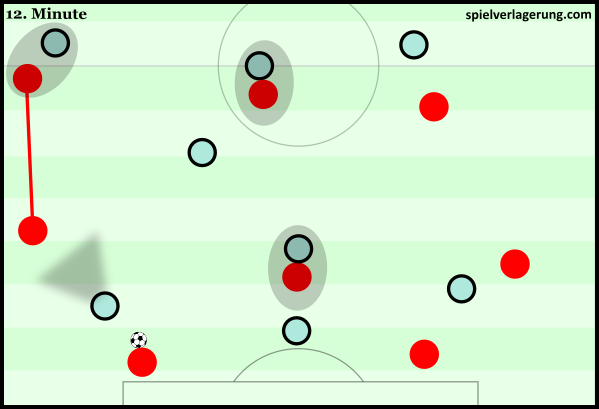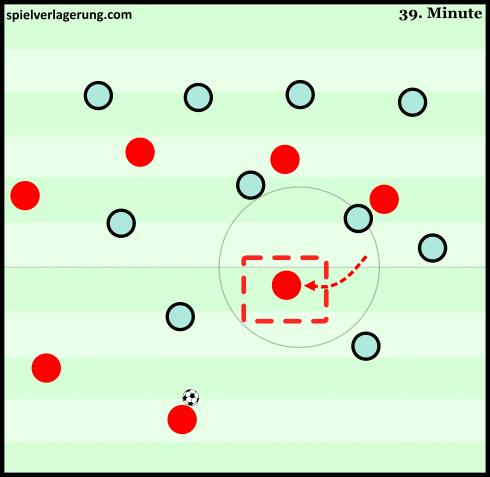Belgium expose transitions against poorly structured Hungary
Bernd Storck’s Hungary took on Belgium in the European Championship round of 16 on Sunday evening. With a squad full of talent Belgium have been labelled dark horses for the competition, however in order to live up to this billing they will need to demonstrate greater team-tactical cohesion than they did in the group stages. Hungary entered the game as one of the unbeaten sides in the competition and one of the highest scorers. They would clearly be no walkover for the Belgians.
Weak Hungarian possession game
For much of the first half Hungary displayed a weak possession game. This was a result of several structural issues that gave them an inadequate basis to create attacks and sustain possession. One of the major issues was their consistent double wing occupation. In several phases of their possession game the Hungarian full backs and wingers both occupied positions on the flanks. In Hungary’s early build-up this meant that Belgium required less players to prevent passes into both the full back and winger. This poor staggering thus gave Belgium the potential to benefit from a defensive overload elsewhere.
Furthermore this positioning in addition to the inconsistent structuring of the central midfielders often meant they lacked presence in the half spaces. This had predictably adverse effects. The half spaces are notoriously advantageous for several reasons not least for the variability they can provide. With the ability to move directly to either the flanks or the centre, which have severely different characteristics, preparing for actions in the half spaces are more difficult.
However with their lack of presence in these areas Hungary neglected its potential benefits. Furthermore the forward pair of Pinter and Szalai were static far too often which meant they lacked the ability to create any separation from their direct opponents. With their stale positioning, marking them out of the game was a simple job for Belgium’s midfield and defensive lines. With a limited ability to play in the centre and a lack of presence in the half spaces it was no surprise that Hungary spent large periods of their possession phases playing in wide areas.
When a possession phase on one side of the field becomes stale through the opponents gradually creating access, switching is a useful tool to escape this pressure. Half space switches however are generally more effective than switches to the opposite flank due to the reduced amount of distance the ball has to travel which gives the opponents less time to react. However with no presence in the half spaces Hungary’s switches had to be made via the defensive line before making it into the opposite flank. In these wide areas the aforementioned poor staggering meant that retaining possession in these areas was not simple, and they were easily forced into turnovers as their poor structures led to poor collective press resistance.
With little or no ability to penetrate Belgium’s block the rare occasions Hungary reached the final 3rd were often made in unstable fashion with direct passes down the flanks. The lack of action the forward players saw translated into hasty and frustrated actions when they did get the ball. These included erratic long shots and crosses from unsuitable positions.
Dzsudzsak as free man
Towards the end of the first half Hungary began to sustain attacks with increasing frequency and found it far easier both to maintain possession centrally and to progress beyond Belgium’s midfield line. The main factor behind this was Dzsudzsak’s central drifting.
As the nominal right winger Belgium’s left back Vertonghen was tasked with marking him in their man-oriented defensive scheme. However by drifting into midfield he moved into areas that Vertonghen was not willing or licenced to follow him into. Furthermore the Belgium midfielders were pre-occupied with their own man-marking assignments which meant that this simple movement created a free man.
As the free man in the centre Dzsudzsak could receive passes from the centre backs and drive forwards challenging Witsel or Nainggolan to leave their opponents and pressure the ball. This allowed the likes of Pinter and Gera to evade their opponents and create angles to receive the ball in the 10 space.
Belgium’s offensive game
Whilst Hungary experienced great difficulty in bypassing Belgium’s man-orientations, Belgium struggled far less for a number of reasons. One of these was due to Hungary’s system; with Szalai as the lone forward covering both half spaces was a frankly impossible job. Belgium could thus create space for their centre backs to drive forwards rather easily at times through use of Courtois or wall passes from the midfielders. With the excellent passing qualities both Alderweireld and Vermalen possess these situations were rather favourable.
With space to step forwards and great passing ability the Belgian centre backs could easily integrate the forwards ahead of them. Despite man-orientations from their Hungarian counterparts good movement from the likes of Lukaku meant they could be used to bounce passes off and move the ball into better positions.
In the final 3rd they showed at times interesting attacking variability. The positioning of Hazard in these situations often hinted at or determined the type of attack they would execute. In the situations that Hazard hugged the touchline Belgium looked to create isolations against for him against Lang (Hungary’s right back). Such situations would allow Hazard to use his dribbling ability and speed to create openings in the Hungarian defence. When used in such a purposeful manner it is clear that dribbling possesses far more than aesthetic qualities. When directly against Lang Hazard looked to use his superior speed to drive towards the byline and deliver crosses into the penalty area.
When Hazard was located more infield, however, Belgium aimed to break through the middle with fast interactions and runs off the ball. At times he would even move over to the opposite flank where his and Mertens’ excellent ability in tight spaces could be used to devastating effect.
2nd half
Belgium did not seem to have an answer to Dzsudzsak’s movements and a continued use of this strategy in combination with Belgium’s increased defensive passivity gave Hungary the basis to dominate territory and create constant attacks. Revelling his new role, Dzsudzsak’s forays even took him as far as the left half space from where he could supply crosses and set up one or two dangerous opportunities.
Belgium’s offensive transitions
With Hungary increasingly desperate to find an equaliser Belgium’s counter attacks became a prominent feature of the game. In these situations France used the superb ball carrying skills of the likes of Hazard, Mertens, De Bruyne and later Carrasco to get the ball into the final 3rd at speed. Upon arriving in the final 3rd Lukaku was often used for wall passes or his diagonal runs used to create space for the ball carrier to move forwards and shoot. 
Despite the somewhat individual nature of these counter attacks, Hungary found it difficult to isolate the ball carriers for a number of reasons. Firstly their positional structures were still poor and a lack of offensive access to the half spaces translated naturally into a lack of defensive access. With these poor structures they were unable to cover the passing options necessary to isolate the ball carrier. Furthermore during the time it would take to cover the passing options available the speed of the likes of Hazard means Belgium could already have advanced past the areas that Hungary prepared to create access in.
These aspects were summed up perfectly in Hazard’s goal as a simple half space switch was enough to allow Belgium to move from an area of moderate pressure to one with none at all.
Conclusion
Despite improving in the second half and perhaps even being unfortunate not to score, Hungary’s structural deficiencies proved to be their undoing in several ways. By going behind and attacking with such weak structures Hungary exposed themselves to great risk and it is no surprise Belgium punished these errors.
Finally Belgium have recorded a commanding win and the so called “golden generation” will fancy their chances of advancing further despite a tough clash against Wales on the horizon. There is no doubt Belgium rely on the talents of the likes of Hazard to create danger and lack a cohesive offensive game plan. If these issues are not addressed Wilmots could find his side going out earlier than expected against a strategically strong Wales side.



Keine Kommentare vorhanden Alle anzeigen